Hantavirus

What is hantavirus?
Hantavirus is the common name for hantavirus pulmonary syndrome (abbreviated as HPS), which is caused by Sin Nombre virus. The virus is passed to humans when these materials get swept up into the air and inhaled.
Sin Nombre virus is not carried by house mice (Mus musculus), rats (Rattus spp.), squirrels (Sciurus spp.), or woodrats (Neotoma spp.). Sin Nombre virus IS carried by native deer mice (Peromyscus maniculatus) and shed in their urine, feces, or saliva.
Hantavirus pulmonary syndrome is a rare but serious respiratory disease that affects people mostly in rural and open space-adjacent areas of the western United States. The fatality rate is approximately 30%. No chronic infection has ever been reported in humans, and it cannot be passed between people.
How common is hantavirus infection in people?
Hantavirus pulmonary syndrome is rare. From 1980 to 2023, were 91 cases of hantavirus disease reported in California residents. There have not been any human cases reported in San Mateo County. The majority of California cases are reported from rural, mountainous areas above 2900 ft elevation. However, there was one case reported in Santa Cruz in 2018.
See hantavirus infection statistics in the United States since 1993
Does Sin Nombre virus occur in San Mateo County?
Yes, Sin Nombre virus has been found in wild mice in San Mateo County. Disease surveys regularly detect very low levels of hantavirus in San Mateo County. However, there have not been any human cases. You can find specific information about hantavirus detections in San Mateo County HERE.
What kinds of rodents carry hantavirus?
Native deer mice in the genus Peromyscus can carry Sin Nombre virus, which causes hantavirus pulmonary syndrome. It is not carried by house mice or rats.
Deer mice are found in rural or open space-adjacent areas of San Mateo County. They may infest storage sheds, abandoned vehicles, tack rooms, or outbuildings that are sealed or locked for long periods of time. It is rare for them to infest homes; however, all wild rodents should be treated with care and eliminated as quickly as possible from all structures.
How do people get hantavirus?
People may be exposed to hantavirus through the urine, feces, nesting materials, or saliva of wild mice. Any activity that puts you in contact with these items puts you at risk of infection. The virus must enter your lungs in order to cause hantavirus pulmonary syndrome. For this reason, any activity that can cause these materials to become airborne, such as sweeping, puts you at higher risk. Activities which pose the highest risk include:
- Cleaning rodent-infested barns, sheds, or abandoned dwellings
- Disturbing rodent nests while hiking or camping
- Living in or visiting areas infested with rodents
- Working in enclosed spaces infested with rodents
Hantavirus is not spread from person to person. You cannot become infected by being near a person who is sick. Pets are not known to transmit hantavirus to people. The virus can be killed by most household disinfectants, such as Lysol, bleach, or alcohol. Learn more about preventing hantavirus transmission.
How can I protect myself when I clean up?
The most important method in preventing exposure to hantavirus is preventing mice from moving into your home. Tips on preventing rodent infestations can be found HERE.
It is important to avoid creating airborne particles of dust and debris while cleaning. For this reason, use wet cleaning methods.
- Open all the doors and windows and allow the building to air out for at least 30 minutes (overnight if possible). This is important for cleaning buildings that might have had deer mice in them, such as sheds or seasonal cabins in rural areas. Leave the area while the building is airing out.
- Wear latex or nitrile gloves and a particle filtering mask like an N95 mask. If it is a heavy rodent infestation, you may need a more protective mask/filter/respirator. Learn more HERE.
- Spray all surfaces with a bleach solution or other disinfecting solution. Always read the label! Do not mix products that contain bleach and ammonium. Apply at maximum recommended concentrations and allow to sit for at least 15 minutes.
- DO NOT SWEEP OR VACUUM (that can blow particles like the virus into the air). Instead, use paper towels or a mop.
- Double bag the disinfectant-soaked materials securely in plastic bags and seal.
- Wash gloved hands in disinfectant, rinse with water, and then remove the gloves. Dispose of gloves and double bagged material.
- Wash your hands with soap and water when done with cleaning and disposing of waste.
What are the symptoms of hantavirus infection?
Learn more about hantavirus signs and symptoms on the CDC's hantavirus webpage.
Hantavirus: Reducing Risk and Exposure
How to Clean Up a Dead Mouse in a Trap
Page last reviewed: May 5, 2025
